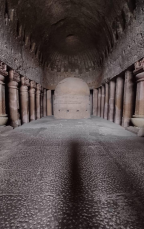Introduction to Kanheri Caves:
Kanheri caves play an important role in the history of architecture. Also known as ‘Krishnagiri’, the name
suggests that the caves were built on the black mountains. The massive rock-cut architecture on the basalt rock is impressive, as it takes us back to the previous era while piquing our curiosity about its construction.
Appearance as a whole:
Texture:


The caves have endured for over a thousand years. As seen in the picture above, there were unorganised and uneven cuts in the surfaces of the caves due to their continuous exposure to humidity and heat. The rocks appeared to be ruined due to their deterioration and abrasion.

One could be intrigued to discover more about its history because it appeared like crushed rock particles attached were arranged in a pattern. The pillars eventually had become fragile. There were steel rods that had been placed between them for restoration purposes. As the caves were storied at various levels, natural rock-cut stairways and a few cemented stairways were created for the visitors. The ‘renovated’ place created appropriate access to all the caves over the hill.


Light:
The amount of light entering the caves was altered by the fact that many of them faced the west. Majorly the caves on the first level were hollow enough to accommodate a gathering of monks. Consequently, a great deal of light penetrated that cave. However, the higher-level caves were just deep enough for a single monk to live in. Additionally, the daylight would help complete the necessary amount of daily chores. It was a centre for learning and contemplation.

The site from Cave 3 depicts the area of gathering for the monks. The cave created a sense of pleasure in one’s body and soul. If one were to stand in the centre of the cave, they would only be interested in hearing the sounds around them. It didn’t seem necessary to open one’s eyes and focus on the sense of sight; even though the carvings on the pillars were intriguing, one would be absorbed in the echo and the silence that had formed inside.
Feelings evoked by the caves:
Texture:

The subsurface was rigid and unyielding. The floor has pores at various places to keep its hold during
monsoons. Walking on such a basis caused every foot-related nerve to be appropriately sensitive because of the foot’s accustomed sensitivity to the simple marble flooring. While meditating in one of the caves, the sound of running water, the rustling of trees, and birds chirping all contributed to the tranquil atmosphere. The setting was developed away from the bustle of daily life. Any person would love nature because of its tranquilly.
Light:


Such gaps between the caves that highlighted parts of the sculptor and enhanced its meaning would drag one’s attention. Light entering the cave from every end seemed to have a deep meaning behind creating those gaps at a particular level and angle. Such gaps between the caves that highlighted parts of the sculptor and enhanced its meaning would drag one’s attention. Light entering the cave from every end seemed to have a deep meaning behind creating those gaps at a particular level and angle.
The atmosphere outside the cave heated up during the sun, which made a person dip in sweat. However, one might feel the coldness while remaining inside. Meditating inside the cave also gave a moderate
environment where warmth and coldness were equally balanced. It helped me concentrate while meditating.
Present circumstances:
Texture:

The ground had become extremely slick due to the rainfall. Water-filled puddles made the ascent up the hill extremely cautious. The cave walls were somewhat damp from above as if the roof had leaked. Even though it appeared wet, it had almost the same feel as previously but was slightly looser.
Light:

Proper depth was created while the shadow showed inside the cave. The inner small rooms were extremely dark, which made it difficult to look through the naked eye, even during broad daylight. In a place environment where one doesn’t wish to use technology, walking to the darkroom, it felt necessary to turn on the flashlight to get a clear view of the area. Anyone entering Cave 3 would feel a sense of mystery as they passed by the area behind the row of pillars. The long pathway encircling the stupa, at an off-centre of the cave, made it worse as it was a narrow pathway covered with long pillars on one side and a wall on the other. While the entire cave was illuminated by the sunshine, walking along this trail incited terror and excitement.
Conclusion:
Kanheri caves being one of the largest Buddhist monasteries, the caves are left to be discovered completely. It is important to know that the caves still provide people with the same sense of peace and silence as required during old times. The caves had established their jurisdiction due to their location in the centre of the extensive forest line. How environmentally responsible it was to coexist peacefully with nature without interfering.
About Author:
Radnyee is an avid reader. Her curiosity encouraged her to do a variety of study projects. She enjoys arts and crafts tremendously. Through her talent for drawing, she can express her creative side. She researches a wide range of topics beyond her comfort zone. She thoroughly researched the Kanheri caves due to her thirst for information, thus being able to spread the knowledge and her experience through it. She embraces problems that come her way since she is a realist. While steadfast in her primary convictions, she is open to various possibilities. She has a fierce and tenacious approach to any new issue.



